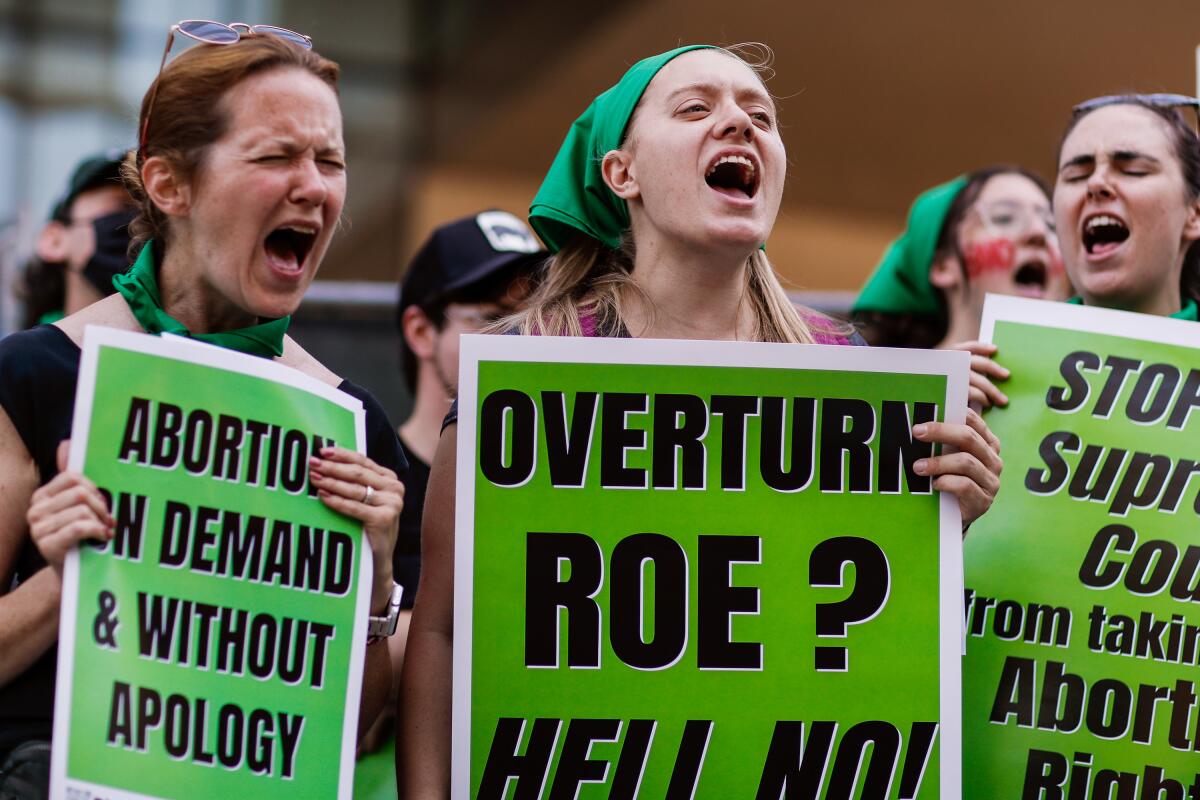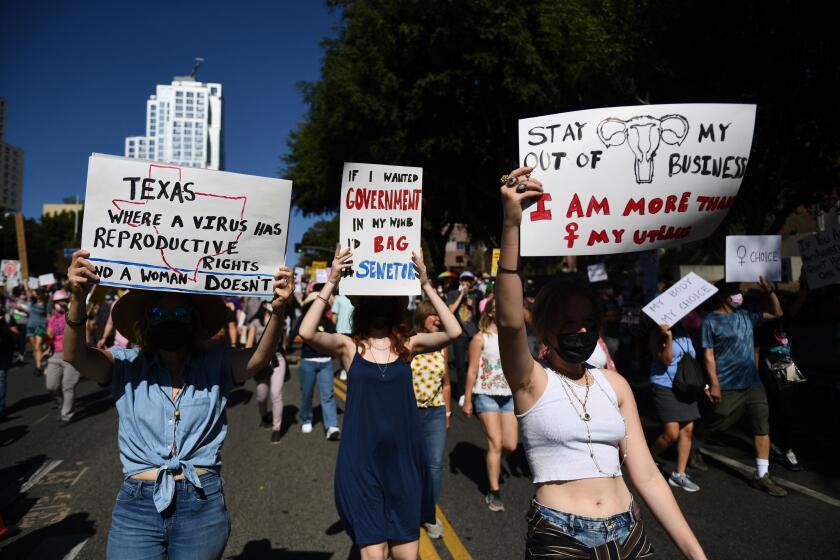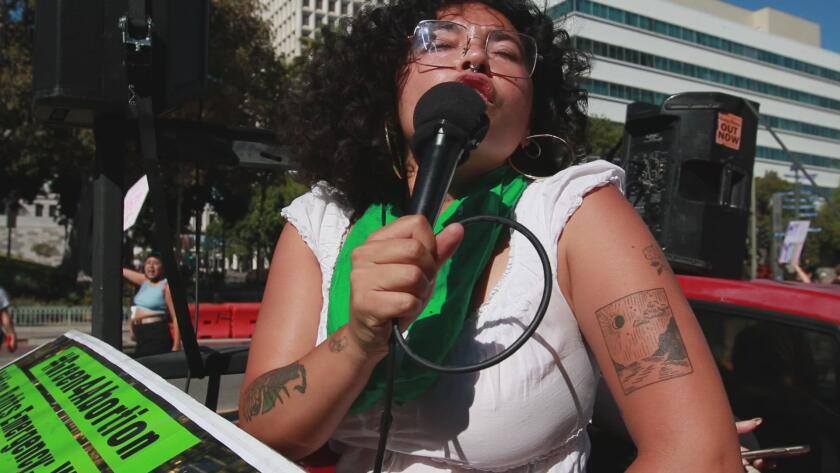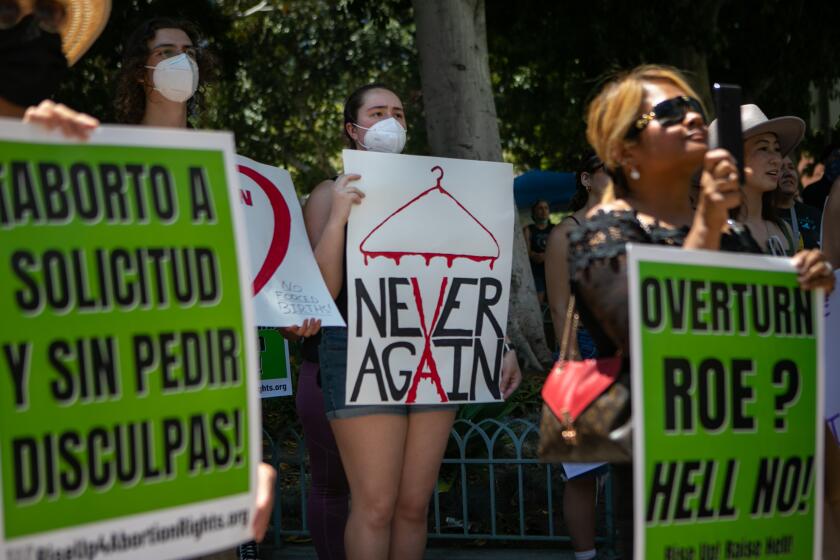What would California’s constitutional amendment on abortion do?

- Share via
SACRAMENTO — California voters in November will consider a constitutional amendment enshrining abortion rights.
The basics
Senate Constitutional Amendment 10 would, if approved by a majority of voters, further codify the state’s already progressive reproductive rights, which grant anyone of reproductive age “the fundamental right to choose to bear a child or to choose and to obtain an abortion.” Currently, those rights in California are upheld by case law and statutory laws, but Senate President Pro Tem Toni Atkins (D-San Diego), who proposed the amendment, said hostile attacks on abortion access convinced her those aren’t enough.
The actual text
“The state shall not deny or interfere with an individual’s reproductive freedom in their most intimate decisions, which includes their fundamental right to choose to have an abortion and their fundamental right to choose or refuse contraceptives. This section is intended to further the constitutional right to privacy guaranteed by Section 1, and the constitutional right to not be denied equal protection guaranteed by Section 7. Nothing herein narrows or limits the right to privacy or equal protection.”
Here is the full language of SCA 10.
California law allows a woman to have an abortion until the point that a physician determines “there is a reasonable likelihood of the fetus’ sustained survival outside the uterus without the application of extraordinary medical measures” or if the procedure is necessary in order to “protect the life or health of the woman.” Those rights are afforded to anyone who becomes pregnant, regardless of age. That includes minors, who under state law can consent to an abortion without a parent’s knowledge.
States will now be permitted to ban abortions for the first time since the landmark Roe vs. Wade decision in 1973. What does this mean in California?
State law does not stipulate the exact point in a pregnancy when viability occurs, instead allowing a physician to make that determination based on “good faith medical judgment.” In most cases, doctors have considered a fetus viable at 24 weeks.
The background
Abortion rights are protected under the California Constitution in two ways. The California Supreme Court held in 1969 that women have a fundamental right to choose whether to have children based on a right of privacy or liberty in matters related to marriage, family and sex.
“The court did this interpreting ‘liberty’ in the California Constitution, just as the U.S. Supreme Court did four years later in Roe vs. Wade,” said Erwin Chemerinsky, dean of the UC Berkeley School of Law.
- Share via
Dozens of people gathered in front of the federal courthouse in downtown Los Angeles on Monday to oppose the Supreme Court’s overturning of Roe vs. Wade. Activists said they planned to continue their protests until the court’s decision is reversed.
In 1974, the state Constitution was amended to include the right to privacy. Seven years later, the state Supreme Court concluded that constitutional privacy protection included the right for a woman to choose an abortion.
California’s governor clearly embraces his rise as a dominant, resonating voice for Democratic states nationwide
“California has been at the forefront of protecting abortion rights and is continuing to lead the way,” said Elizabeth Nash of the Guttmacher Institute, a research organization that supports reproductive health and abortion rights. “Abortion opponents are already thinking about where they go to next.”
Because support for abortion rights is so strong here, Chemerinsky said the added protection provided by the constitutional amendment is “more symbolic than anything else.”
Why now?
California sees itself as a leader in the abortion rights movement, particularly since the U.S. Supreme Court’s decision to overturn Roe vs. Wade.
“California will not back down from the fight to protect abortion rights as more than half the states in this country, enabled by the Supreme Court, ban or severely restrict access,” Gov. Gavin Newsom said Monday.
Among likely voters in the state, 76% said they did not want Roe vs. Wade overturned, according to a poll earlier this year by the nonpartisan Public Policy Institute of California.
With Roe vs. Wade now overturned, here is a breakdown of what California is doing to protect abortion rights.
California has been preparing for months for the likelihood that thousands of people would travel to the state from areas where bans are resurrected. UCLA’s Center on Reproductive Health, Law and Policy released a report this month estimating that 8,000 to 16,000 more people will travel to California each year for abortion care. That includes up to 9,400 more people from antiabortion states seeking care in Los Angeles County alone, according to the report.
Newsom on Friday joined Washington Gov. Jay Inslee and Oregon Gov. Kate Brown in announcing the creation of a “West Coast offensive” to protect access to reproductive care. The plan includes continued safeguards for out-of-state patients, defense of medical professionals who provide abortion services and efforts to prevent misinformation and expand access to care, the governors said.
Newsom issued an executive order Monday that said California will not share medical records with antiabortion states or extradite doctors who provide care to patients seeking the procedure here.
What are backers saying?
“We know from history that abortion bans don’t end abortion,” said Assembly Speaker Anthony Rendon (D-Lakewood), a co-author of SCA 10. “They only outlaw safe abortions. We must preserve the fundamental reproductive rights of women here in California because they are under attack elsewhere.”
“Today, we provide a ray of hope by enabling voters to enshrine reproductive rights in our Constitution, reflecting California’s values and protecting all who need abortion, contraceptives and other reproductive care in our state,” Atkins added.
How about critics?
Republicans raised concerns that the measure does not set restrictions on when abortions can be performed.
“If you believe in souls and that we’re God’s creatures, when does the baby get the soul?” said Assemblyman Randy Voepel (R-Santee). “You might want to think about that.”
Republican Assembly Leader James Gallagher (R-Yuba City) said SCA 10 lacked clarity on whether it would change the state’s current law on when abortions are permitted after viability.
Marjorie Dannenfelser started out as a pro-choice Republican. After changing her mind in college, she set out to outlaw abortion across the United States.
“It says nothing about late term,” Gallagher said. “It puts no restrictions on it.”
More to Read
Sign up for Essential California
The most important California stories and recommendations in your inbox every morning.
You may occasionally receive promotional content from the Los Angeles Times.
















